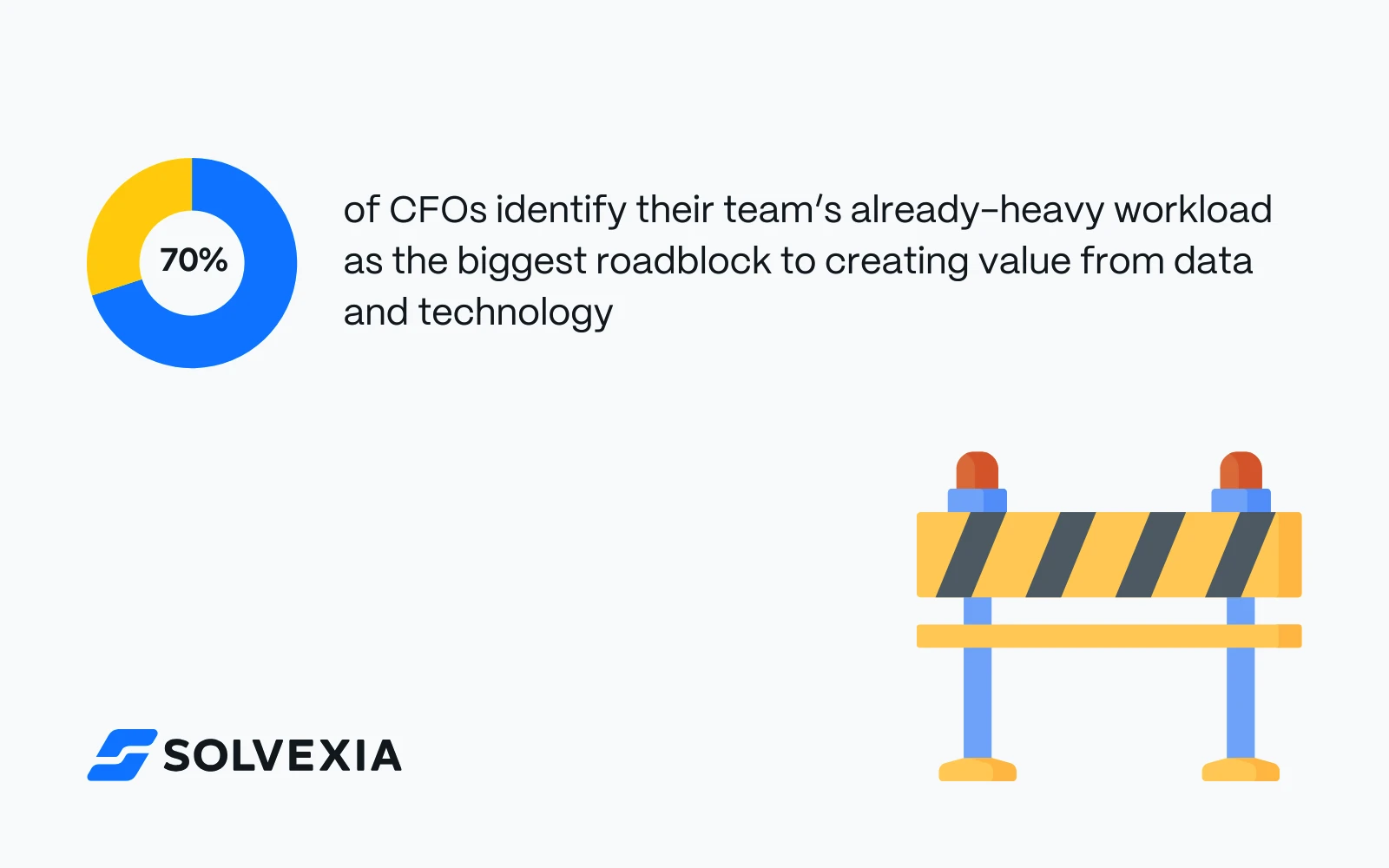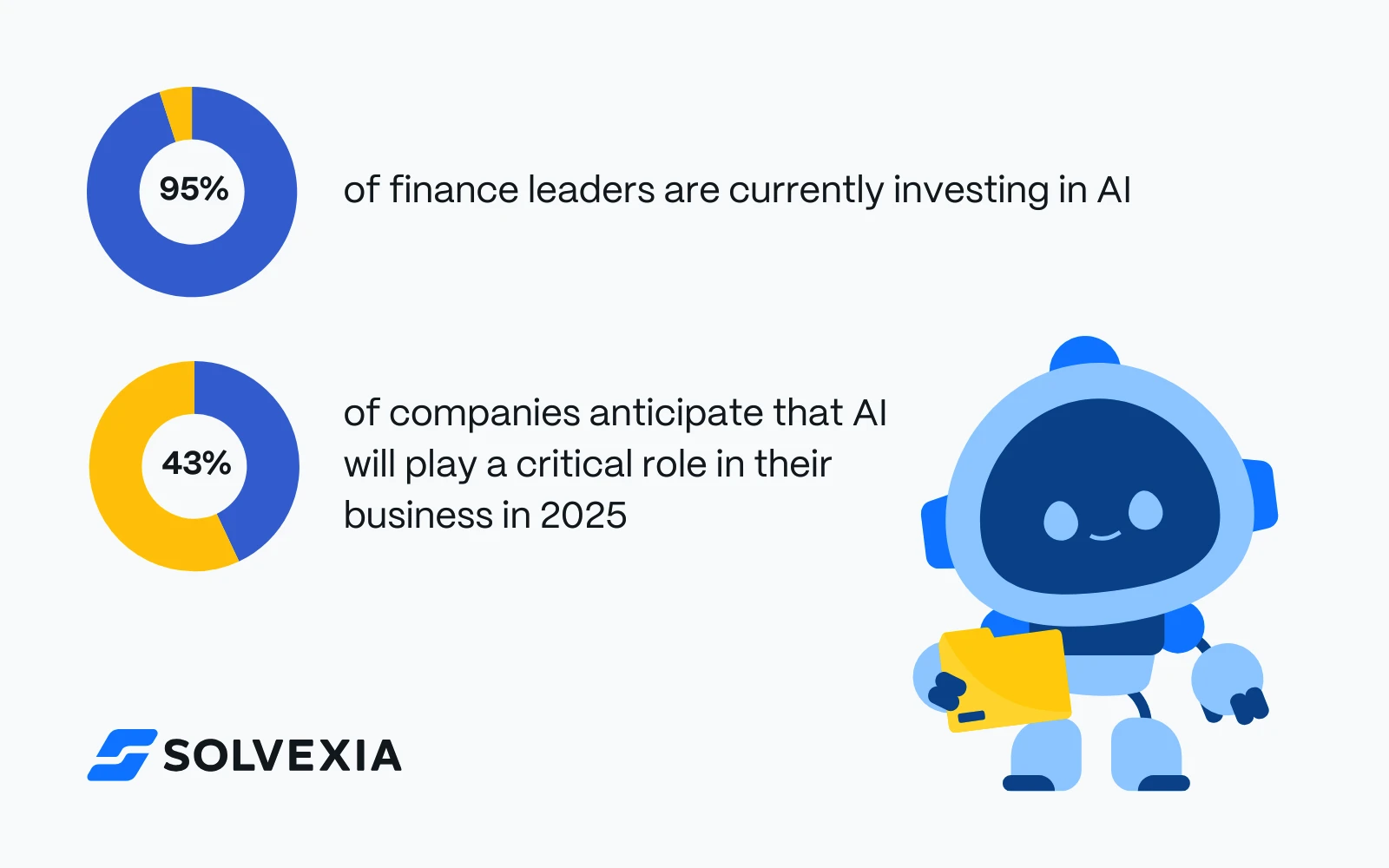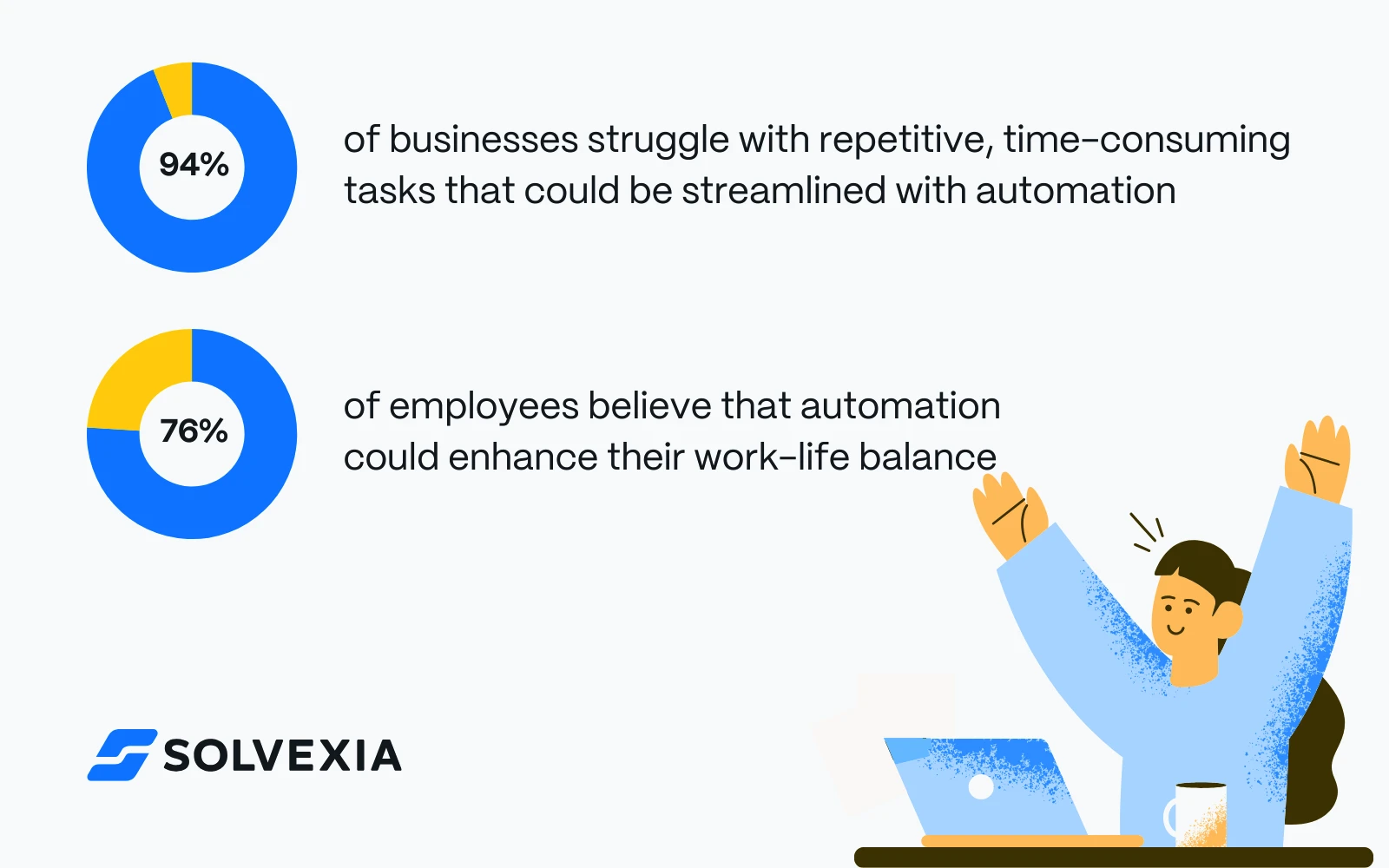32 Finance Automation Trends and Statistics for 2026

As we head into 2026, finance automation trends are reshaping the industry at an unprecedented pace. The financial sector stands at a pivotal moment of transformation, where the convergence of artificial intelligence, automation, and digital technologies is fundamentally changing how financial operations are conducted, talent is developed, and risks are managed.
We'll look at 32 critical statistics that illuminate the future of finance, revealing both the challenges and opportunities that lie ahead for organizations navigating this digital revolution.
Coming Up
The Rise of Finance Automation: Key Trends
The financial sector is experiencing an unprecedented wave of automation adoption, fundamentally changing how organizations handle their core processes. This transformation isn’t just about replacing manual tasks—it’s about reimagining how financial operations can be conducted in an increasingly digital world.
Business process automation trends in finance reveal a sector eager for change but still navigating the complexities of implementation. While past financial industry trends focused on cost reduction and efficiency, today’s automation initiatives are increasingly centered on value creation, data accuracy, and strategic decision-making.
Properly designed automation solutions are crucial in enhancing operational efficiency and mitigating processing errors. Poorly implemented automation solutions can negatively impact IT infrastructure and slow down operations, underscoring the need for proper implementation and oversight to maximize the benefits of automation in business processes.
What is Finance Automation?
Finance automation is the use of advanced technology to streamline and automate specific manual tasks within the financial sector, such as accounting, bookkeeping, and financial analysis. By setting up automated workflows and leveraging artificial intelligence, businesses can trigger predefined steps that were previously performed by humans. This shift is a crucial aspect of digital transformation in finance, enabling organizations to enhance operational efficiency, reduce errors, and focus on strategic decision-making. With finance automation, companies can reimagine their financial processes, making them faster, more accurate, and more reliable.
Key Finance Automation Statistics for 2026
Digital Transformation Trends in Finance: The Numbers That Matter
The landscape of financial operations is undergoing a seismic shift. While most finance leaders acknowledge the importance of digital transformation, the journey from recognition to implementation reveals both promising advances and significant challenges. A critical component of this journey is having a robust digital transformation strategy, which is essential for operational efficiency and to withstand competitive pressure. As we look at the current state of finance automation, the numbers tell a compelling story.
Here are the key statistics shaping financial digital transformation in 2026:
- 98% of CFOs report that their finance teams have invested in some form of digitization or automation initiatives.
- 41% of CFOs say that less than a quarter of their finance processes are currently digitized or automated.
- 70% of CFOs identify their team’s already-heavy workload as the biggest roadblock to creating value from data and technology.
- Optimizing financial processes through automation and digitization can cut time spent on tasks by 30-40%.
- Almost 88% of organizations state that their primary motivation for adopting automation is to improve business processes.
- Financial automation reduces reporting errors by 90%.
- Teams complete financial processes 85x faster with automation.
- Businesses typically achieve ROI within 6-12 months of implementing financial automation.
- 94% of business professionals at enterprise companies would prefer a unified platform that integrates applications and automates workflows over managing multiple separate systems.
- Automation enables finance teams to complete their reconciliations 100x faster.
- Embracing citizen development can boost an organization’s innovation score by 33%.

What these numbers reveal is a finance sector at a critical inflection point. While nearly every organization has taken initial steps toward digital transformation, the depth of implementation varies significantly. The potential for efficiency gains is enormous – from 90% fewer reporting errors to 85x faster processing times – yet many teams find themselves caught in a paradox: too busy with current workloads to implement the very solutions that could alleviate their burden.
The path forward is clear: organizations that successfully navigate the initial implementation challenges stand to gain significant competitive advantages through enhanced efficiency, accuracy, and innovation. As we move into 2026, these statistics serve as both a benchmark and a wake-up call for finance teams still early in their digital transformation journey.
AI and Robotic Process Automation in Finance: From Experimental to Essential
The rise of artificial intelligence in financial operations marks a transformative shift in how organizations handle data, make decisions, and manage risks. Particularly with the emergence of generative AI, we’re seeing a rapid evolution from experimental applications to mission-critical tools. While some organizations are still testing the waters, others are diving deep into AI implementation, creating a landscape of varied adoption rates and applications.
AI plays a crucial role in generating data insights that drive growth and support decision-making across various business sectors.
Here are the key AI statistics shaping finance in 2026:
- 1 in 5 CFOs are leveraging generative AI tools, with nearly half of them still in the pilot or experimental phase.
- 95% of finance leaders are currently investing in AI.
- 43% of companies anticipate that AI will play a critical role in their business in 2026.
- Over 90% of SMBs globally are projected to adopt AI for continuous monitoring and anomaly detection by 2030.
- Key AI applications in finance include intelligent process automation (used by 44% of finance teams), anomaly and error detection (adopted by 39%), and analytics to enhance financial forecasting (utilized by 28%).
- 80% of finance executives have either implemented or are planning to implement robotic process automation (RPA).
- 92% of organizations report that RPA has improved compliance in their financial processes.

These numbers paint a picture of an industry in transition. While nearly all finance leaders are investing in AI, the depth and maturity of implementation varies significantly. The gap between current adoption rates and future projections suggests we’re on the cusp of a major shift in how financial operations are conducted. As we move toward 2026 and beyond, AI is clearly moving from a nice-to-have technology to a fundamental component of financial operations.
The Evolution of Finance Talent: New Skills, New Roles, New Expectations
The intersection of technology and finance isn’t just changing how we work—it’s fundamentally reshaping who does the work and what skills they need. As digital technology and automation take over routine tasks, finance professionals are evolving into more strategic roles, creating both challenges and opportunities in talent management. The transformation is clear: traditional finance roles are giving way to hybrid positions that combine financial expertise with technological fluency.
Here are the key trends reshaping finance talent in 2026:
- CFOs project a 1.1% year-over-year (YOY) growth in hiring.
- 87% of finance professionals report an expanded scope of their work, taking on new responsibilities like data analytics, financial technology integration, and strategic business advisory roles.
- 66% of finance leaders reported that staffing shortages impacted their departments in 2024.
- By 2030, 39% of financial controllers expect their roles to shift toward value creation, moving away from traditional cost optimization and value protection.
- 94% of businesses struggle with repetitive, time-consuming tasks that could be streamlined through automation.
- 75% of employees believe that automation could enhance their work-life balance.

These statistics reveal a sector in transition, where the challenge isn’t just finding talent—it’s finding the right talent with the right mix of skills. While hiring growth remains modest, the expectations and scope of finance roles are expanding dramatically. The high percentage of professionals reporting staffing impacts suggests a critical need to bridge the gap between traditional finance skills and emerging technological requirements.
Risk Management in Finance: Navigating Complexity Through Technology
The risk landscape in finance has become increasingly complex, marked by a convergence of traditional financial risks, technological challenges, and emerging regulatory requirements. As organizations face this evolving risk environment, they’re turning to automation and advanced technologies not just to manage risks, but to transform how they approach compliance and reporting altogether.
Digital transformation efforts are critical in enhancing risk management and compliance, enabling organizations to navigate the complexities of today's competitive landscape effectively.
Here are the key risk management statistics shaping financial decisions in 2026:
- When ranking their top three external concerns, 57% of CFOs mentioned inflation, 54% cited the economy, and 52% pointed to geopolitical issues.
- Among their top three internal risks, 49% of CFOs highlighted technology transformation, 48% pointed to efficiency and productivity, and 44% listed generative AI.
- 65% of executives report a substantial rise in the volume and complexity of risks over the past five years.
- 69% of businesses intend to boost their investment in data and technology for risk management.
- Financial institutions are projected to increase their investment in regulatory technology (RegTech) by 128% between 2023 and 2030.
- Increasing automation by 15% can reduce compliance costs by 10% for most companies.
- 74% of public companies plan to invest in sustainability reporting technology within the next year to streamline the collection, analysis, and reporting of ESG data.
- 99% of companies are gearing up for stricter disclosure requirements in response to new regulatory sustainability reporting mandates, such as the EU’s CSRD and the SEC Climate Disclosure Rules in the US.
These numbers highlight a clear trend: organizations are facing a perfect storm of traditional financial risks, technological disruption, and increasing regulatory demands. The response is equally clear – a strong pivot toward technological solutions, particularly in areas like RegTech and ESG reporting. The substantial projected growth in RegTech investment, coupled with the near-universal preparation for stricter disclosure requirements, signals a new era in risk management where technology plays a central role.
Processes to Automate
Accounts Receivable and Payable
Accounts receivable and payable are two critical financial processes that can greatly benefit from automation. By utilizing advanced automation tools, businesses can streamline their invoicing and payment workflows, significantly reducing errors and improving cash flow.
For instance, automated accounts receivable systems can send timely reminders to customers, update payment records, and reconcile accounts seamlessly. On the other hand, automated accounts payable systems can handle invoice processing, payment approvals, and execution with minimal human intervention. This not only enhances efficiency but also ensures that financial operations are more accurate and timely, ultimately contributing to better financial health for the organization.
Financial Close and Reporting
Month-end close processes become more efficient through automation, with faster account reconciliations and streamlined journal entry creation and posting. Financial statement preparation, management reporting, and compliance reporting can be automated to reduce time and errors. Automation also enables more sophisticated variance analysis and real-time reporting capabilities.
Treasury Management
Treasury operations benefit from automated cash flow forecasting and bank reconciliations. Investment management processes, foreign exchange transactions, and working capital optimization can be streamlined through automation. Liquidity management becomes more precise, and bank fee analysis more thorough with automated systems.
Tax Management
Automating tax processes ensures greater accuracy and compliance while reducing manual effort. This includes tax calculation and validation, compliance monitoring, and return preparation. Supporting documentation becomes easier to manage, tax provision analysis more accurate, and transfer pricing calculations more consistent through automation.
Financial Planning and Analysis
FP&A processes become more sophisticated through automation, enabling more accurate budget preparation and forecasting. Performance tracking and scenario analysis can be conducted more frequently and with greater detail. Management reporting becomes more timely and insightful, with automated KPI monitoring and variance analysis.
Procurement and Spend Management
Automating procurement processes streamlines purchase requisitions and order creation while improving vendor management. Contract management becomes more systematic, spend analysis more detailed, and supplier performance tracking more consistent. Category management benefits from automated data analysis and reporting.
These processes represent key opportunities for automation, offering significant potential for efficiency gains, error reduction, and improved financial control. Organizations typically begin with one or two core processes and gradually expand their automation footprint based on success and lessons learned.
Robotic Process Automation in Finance
Robotic process automation (RPA) is a powerful subset of finance automation that employs software robots to handle repetitive and rule-based tasks. RPA can be applied to a wide range of financial processes, including data entry, invoice processing, and payment execution. By automating these routine tasks, businesses can significantly improve operational efficiency, reduce errors, and boost productivity.
For example, RPA can automate the processing of invoices, payments, and receipts, freeing up finance staff to focus on higher-value activities such as financial analysis and strategic planning. As the digital transformation market continues to evolve, RPA is set to play an increasingly vital role in helping businesses achieve their financial goals. By embracing robotic process automation, organizations can enhance their financial management, reduce costs, and drive business growth, positioning themselves for success in an increasingly digital world.
Benefits of Finance Automation
As finance automation trends continue to evolve, organizations are discovering that the benefits extend far beyond simple cost reduction. The impact of modern business process automation trends spans across operational efficiency, risk management, and strategic capabilities, creating a compelling case for digital transformation. Finance transformation plays a crucial role in driving these benefits by digitizing financial processes and automating manual tasks.
Here are the key benefits driving automation adoption:
1. Operational Efficiency
- Reduction in time spent on routine tasks
- Financial processes completed 85x faster
- Reconciliations accelerated by 100x
- ROI typically achieved within 6-12 months
2. Enhanced Accuracy and Control
- 90% reduction in reporting errors
- Improved compliance through standardized processes
- Better audit trails and documentation
- Real-time visibility into financial operations
3. Strategic Value Creation
- Finance teams freed to focus on analysis and strategy
- Better data quality for decision-making
- Faster reporting cycles
- Enhanced forecasting capabilities
4. Risk Mitigation
- Reduced human error in critical processes
- Improved compliance monitoring
- Better detection of anomalies and fraud
- Consistent application of controls
These benefits help explain why 88% of organizations cite business process improvement as their primary motivation for adopting automation, and why 94% of business professionals prefer unified automation platforms for their financial operations.
Looking Ahead: The Future of Finance Automation
The statistics presented paint a clear picture of an industry in the midst of profound change. Several key themes emerge from our analysis:
- The Automation Imperative: With 98% of CFOs investing in digitization but only a quarter of processes automated, there’s enormous untapped potential for efficiency gains.
- AI’s Growing Impact: The transition from experimental to essential is clear, with 95% of finance leaders investing in AI and 43% viewing it as critical by 2026.
- The Human Element: As automation reshapes workflows, finance professionals are evolving into more strategic roles, with 87% reporting expanded responsibilities.
- Risk and Compliance Evolution: The 128% projected growth in RegTech investment by 2030 signals a tech-driven approach to managing increasingly complex risks.
- Understanding Digital Transformation Trends: To remain competitive, organizations must stay abreast of digital transformation trends. These trends necessitate strategic shifts, embracing new technologies, and prioritizing digital initiatives to enhance business processes and customer experiences.
For organizations looking to thrive in this new landscape, the message is clear: the future of finance will belong to those who can successfully balance technological innovation with human expertise, while navigating an increasingly complex risk environment. As we move toward 2026, the question isn’t whether to embrace these changes, but how quickly and effectively organizations can adapt to this new reality of financial operations.
Ready to Start Your Finance Automation Journey?
Solvexia's no-code automation platform helps finance teams automate their processes without adding to IT's workload. Our platform enables you to:
- Reduce manual work by up to 90%
- Complete month-end processes up to 85x faster
- Achieve ROI within 6-12 months
- Create a single source of truth for all your financial data
Start transforming your financial operations today. Book a demo to see how we can help you navigate the future of finance.
FAQ
What is automation in finance and accounting?
Automation in finance and accounting refers to the use of technology—such as artificial intelligence (AI), robotic process automation (RPA), and workflow automation tools—to perform routine tasks without manual input. This includes activities like invoice processing, reconciliations, financial reporting, budgeting, and forecasting. The goal is to increase speed, accuracy, and compliance while freeing up finance professionals to focus on strategic initiatives and value-added work.
What are some finance automation examples?
Examples of finance automation include:
- Accounts Payable Automation: Automatically capturing and processing invoices, managing approvals, and issuing payments.
- Reconciliation Automation: Matching transactions across systems and flagging discrepancies in real time.
- Month-End Close Automation: Automating journal entries, accruals, and report generation.
- Cash Flow Forecasting: Using AI to predict future cash positions based on real-time data.
- Tax Compliance: Auto-calculating taxes, generating reports, and ensuring up-to-date regulatory compliance.
- FP&A: Automating budgeting workflows, variance analysis, and dashboard reporting.
These examples demonstrate how automation can streamline complex, repetitive processes, reduce human error, and improve financial decision-making.
Which finance processes are best suited for automation?
High-impact areas include accounts payable and receivable, financial close and reporting, tax management, treasury operations, procurement, and financial planning & analysis (FP&A). These processes often involve repetitive steps and data consolidation, making them ideal for automation.
What are the key finance automation trends for 2026?
Top trends include increased adoption of AI and generative AI tools, growing use of RPA, rising investment in RegTech and ESG reporting technologies, and a shift in finance roles toward strategic, tech-enabled responsibilities. Unified automation platforms are also gaining popularity over fragmented tech stacks.
Intelligent reconciliation solution
Intelligent rebate management solution
Intelligent financial automation solution
Intelligent Financial Automation Solution
Intelligent financial automation solution
Intelligent financial automation solution
Intelligent financial automation solution
Intelligent financial automation solution
Intelligent regulatory reporting solution
Free up time and reduce errors
Recommended for you

Request a Demo
Book a 30-minute call to see how our intelligent software can give you more insights and control over your data and reporting.

Reconciliation Data Sheet
Download our data sheet to learn how to automate your reconciliations for increased accuracy, speed and control.

Regulatory Reporting Data Sheet
Download our data sheet to learn how you can prepare, validate and submit regulatory returns 10x faster with automation.

Financial Automation Data Sheet
Download our data sheet to learn how you can run your processes up to 100x faster and with 98% fewer errors.

Financial Automation Data Sheet
Download our data sheet to learn how you can run your processes up to 100x faster and with 98% fewer errors.

Financial Automation Data Sheet
Download our data sheet to learn how you can run your processes up to 100x faster and with 98% fewer errors.

Financial Automation Data Sheet
Download our data sheet to learn how you can run your processes up to 100x faster and with 98% fewer errors.

Financial Automation Data Sheet
Download our data sheet to learn how you can run your processes up to 100x faster and with 98% fewer errors.

Financial Automation Data Sheet
Download our data sheet to learn how you can run your processes up to 100x faster and with 98% fewer errors.

Rebate Management Data Sheet
Download our data sheet to learn how you can manage complex vendor and customer rebates and commission reporting at scale.

Top 10 Automation Challenges for CFOs
Learn how you can avoid and overcome the biggest challenges facing CFOs who want to automate.
.svg)








